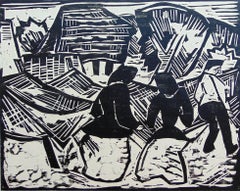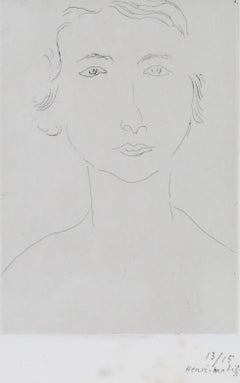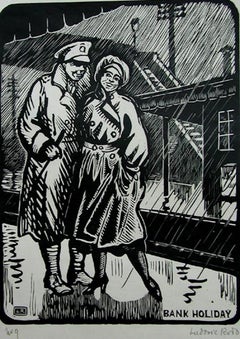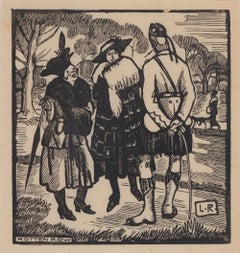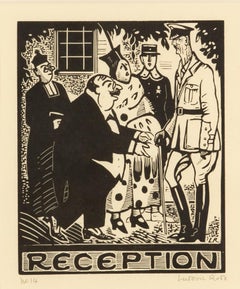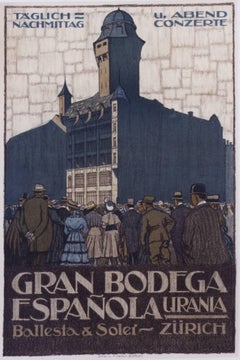1910s Figurative Prints
to
107
398
112
81
14
18
Overall Width
to
Overall Height
to
192
68
21
12
7
1
1
1
101
34
22
18
17
3,481
7,308
25,487
6,780
292
654
1,361
1,188
1,294
2,250
3,645
5,256
2,716
1,278
3,027
418
202
2
558
289
241
210
185
138
125
66
64
62
46
44
44
29
26
24
23
22
20
18
230
193
129
114
73
38
191
309
263
Period: 1910s
By the Nets Bei den Netzen
Located in London, GB
KARL SCHMIDT-ROTTLUFF 1884-1976
Rottluff, Germany 1884 - 1976 Berlin (German)
Title: By the Nets Bei den Netzen, 1914
Technique: Original hand signed woodcut on laid paper
Pape...
Category
Expressionist 1910s Figurative Prints
Materials
Woodcut
Jeune Polonaise
Located in London, GB
Henri Matisse
Jeune Polonaise
1917/18
Etching on Chine appliqué on wove paper, Edition of 15
Paper size: 38 x 28.5 cms (15 x 11 1/4 ins)
Plate size: 18 x 12.7 cms (7 x 5 ins)
HM16662
Category
1910s Figurative Prints
Materials
Etching
Bank Holiday by Ludovic-Rodo Pissarro - Wood engraving
Located in London, GB
SOLD UNFRAMED
Holiday by Ludovic-Rodo Pissarro (1878-1952)
Wood engraving
15.2 x 11.5 cm (6 x 4 ½ inches)
Initialed and titled in the plate
Signed lower right, Ludovic Rodo and nu...
Category
1910s Figurative Prints
Materials
Engraving, Woodcut
Rotten Row (Hyde Park) by Ludovic-Rodo Pissarro - Wood engraving
Located in London, GB
SOLD UNFRAMED
Rotten Row (Hyde Park) by Ludovic-Rodo Pissarro (1878-1952)
Wood engraving
13.5 x 12.5 cm (5 ¼ x 4 ⅞ inches)
Initialed and titled in the plate
Executed circa 1917
Artist biography
Ludovic-Rodolphe Pissarro, born in Paris in 1878, was Camille Pissarro’s fourth son. Encouraged by his father...
Category
1910s Figurative Prints
Materials
Woodcut, Engraving
Reception by Ludovic-Rodo Pissarro - Woodcut
Located in London, GB
Reception by Ludovic-Rodo Pissarro (1878-1952)
Wood engraving
14 x 11.5 cm (5 ¹/₂ x 4 ¹/₂ inches)
Initialed and titled in the plate
Signed lower right, L...
Category
1910s Figurative Prints
Materials
Woodcut
Gran Bodega Espanola Urania, Zurich
By Anton Trieb
Located in New York, NY
Trieb, Anton. Gran Bodega Espanola Urania, Zurich Ca 1910.Color lithograph. On Linen.
Anton Trieb was a watercolor painter , draftsman , illustrat...
Category
Art Deco 1910s Figurative Prints
Materials
Lithograph
Le Docteur Ballanzone
Located in New York, NY
Pochoir Colored Plate for Journal Des Dames et Des Modes. Engraved by H. Reidel on wove paper. 15 x 19.5". 1914
Pochoir is a process where the plate is first stenciled and then ha...
Category
Art Deco 1910s Figurative Prints
Materials
Color, Engraving
Back to the Land “Farming” by Ludovic-Rodo Pissarro - Colour woodcut
Located in London, GB
Back to the Land “Farming” by Ludovic-Rodo Pissarro (1878-1952)
Colour wood engraving
19.3 x 10.5 cm (7 ⁵/₈ x 4 ¹/₈ inches)
Initialed and titled in the plate and numbered, 4th state ...
Category
1910s Figurative Prints
Materials
Color, Woodcut
The Bathers, Woodcut on paper, Signed and dated 1912, Italian Artist
Located in London, GB
Woodcut on paper, signed and dated '1912' bottom right
Image size: 5 x 5 1/4 (12.75 x 13.5 cm)
Mounted
Here the artist's bold gouging of the material has created an evocative scene ...
Category
Italian School 1910s Figurative Prints
Materials
Woodcut
Portrait by Orovida Pissarro - etching
Located in London, GB
Portrait by Orovida Pissarro (1893-1968)
Etching
25 x 16.5 cm (9 ⁷/₈ x 6 ¹/₂ inches)
Signed and dated lower right, Orovida 1919
Inscribed lower left, Trial proof no. 20 and titled lo...
Category
1910s Figurative Prints
Materials
Etching, Paper
"Mlle Landsberg" (grade planche, pl. 16)
Located in Missouri, MO
"Mlle Landsberg" (grade planche, pl. 16), 1914
Henri Matisse (French, 1869-1954)
Signed and Numbered Lower Right
Edition 12/15
Image size: 7 7/8 x 4 5/16 inches
Sheet size: 17 11/16 x 12 1/2 inches
With frame: 19 1/2 x 14 1/2 inches
Henri Matisse came from a family who were of Flemish origin and lived near the Belgian border. At eight o'clock on the evening of December 31, 1869, he was born in his grandparents' home in the town of Le Cateau in the cheerless far north of France. His father was a self-made seed merchant who was a mixture of determination and tightly coiled tension.
Henri had no clear idea of what he wanted to do with his life. He was a twenty-year-old law clerk convalescing from appendicitis when he first began to paint, using a box of colors given to him by his mother. Little more than a year later, in 1890, he had abandoned law and was studying art in Paris. The classes consisted of drawing from plaster casts and nude models and of copying paintings in the Louvre. He soon rebelled against the school's conservative atmosphere; he replaced the dark tones of his earliest works with brighter colors that reflected his awareness of Impressionism. Matisse was also a violinist; he took an odd pride in the notion that if his painting eye failed, he could support his family by fiddling on the streets of Paris.
Henri found a girlfriend while studying art, and he fathered a daughter, Marguerite, by her in 1894. In 1898 he married another woman, Amelie Parayre. She adopted the beloved Marguerite; they eventually had two sons, Jean, a sculptor and Pierre who became an eminent art dealer. Relations between Matisse and his wife were often strained. He often dallied with other women, and they finally separated in 1939 over a model who had been hired as a companion for Mme. Matisse. She was Madame Lydia, and after Mme. Matisse left, she remained with Matisse until he died.
Matisse spent the summer of 1905 working with Andre Derain in the small Mediterranean seaport of Collioure. They began using bright and dissonant colors. When they and their colleagues exhibited together, they caused a sensation. The critics and the public considered their paintings to be so crude and so roughly crafted that the group became known as Les Fauves (the wild beasts).
By 1907, Matisse moved on from the concerns of Fauvism and turned his attention to studies of the human figure. He had begun to sculpt a few years earlier. In 1910, when he saw an exhibition of Islamic art, he was fascinated with the multiple patterned areas and adapted the decorative universe of the miniatures to his interiors. As a continuation of his interest in the "exotic", Matisse made extended trips to Morocco in 1912 and 1913.
At the end of 1917, Matisse moved to Nice; he would spend part of each year there for the remainder of his life. A meticulous dandy, he wore a light tweed jacket amd a tie when he painted. He never used a palette, but instead squeezed his colors on to plain white kitchen dishes...
Category
Fauvist 1910s Figurative Prints
Materials
Drypoint, Etching
Les Otages Civils
Located in San Francisco, CA
This artwork titled, Les Otages Civils, 1916 is an original lithograph on Japan paper by Swiss/French artist Theophile Alexandre Steinlen, 1859-1923. It is signed and numbered out of...
Category
Impressionist 1910s Figurative Prints
Materials
Lithograph
La Marchande de Violettes
Located in New York, NY
Jean-Emile Laboureur (1877-1943), La Marchande de Violettes, etching, 1914, signed in pencil lower left and numbered (33/35) lower right [also signed and dated in the plate lower rig...
Category
Cubist 1910s Figurative Prints
Materials
Etching
Le Diner a L’Auberge
Located in New York, NY
Jean-Emile Laboureur (1877-1943), Le Diner a L’Auberge, 1917-1922), engraving, signed in pencil lower left and numbered (45/55) lower right. Reference: Sylvain Laboureur 173, second ...
Category
Cubist 1910s Figurative Prints
Materials
Engraving
Driving Home in the Rain
Located in Storrs, CT
Driving Home in the Rain. 1914. Drypoint. Appleby 35. 7 3/8 x 10 1/8 (sheet 12 x 15 3/8). Edition 40. Illustrated: Guichard, British Etchers, 1850-1940; Print Collector's Quarterly 1...
Category
Modern 1910s Figurative Prints
Materials
Drypoint
Le Gramophone
Located in New York, NY
LABOURER, Jean Emile. Le Gramophone. Woodcut on cream laid paper,
1918-21.
full margins. Signed and numbered 41/45 in pencil, lower margin.
A very goo...
Category
Cubist 1910s Figurative Prints
Materials
Woodcut
